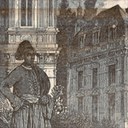0145 Performing Dumas
Architecture and Mise en Scène at the Château de Monte-Cristo
Identifiers (Article)
Identifiers (Files)
Abstract
When Alexandre Dumas père was at the peak of his success and popularity, he was personally involved in the design and construction of the Château de Monte-Cristo (Port-Marly, France, 1847). The architectural and ornamental features of this lavish abode can be interpreted as a reflection of Dumas’ literary ambition, as a complex aesthetic portrait. Dumas’ mise en scène of his whole life as artwork prompted him to create an elaborate display of visual rhetoric, an interplay of images and words developed through a physical and allegorical relationship with a place now appropriated by and absorbed into his persona. It is essential, therefore, that information on Dumas’ life and literary career may be combined with an iconographic analysis as a means of decoding the meanings bound up in the spectacle buildings at the Château de Monte-Cristo.
Statistics


License

This work is licensed under a Creative Commons Attribution-NonCommercial-NoDerivatives 4.0 International License.



